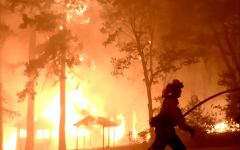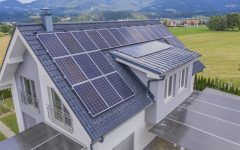
Federal Roadmap Paves Way for Solar Expansion on Western Public Lands
By TheNevadaGlobeStaff, September 2, 2024 3:34 pm
The U.S. Bureau of Land Management (BLM) unveiled a new plan on Thursday, opening up vast swathes of public land in 11 western states, including approximately 32 million acres, for utility-scale solar energy development. This revised Western Solar Plan, an update to a decade-old plan, aims to strategically guide solar development over the next two decades, focusing on areas with high solar potential and minimal environmental conflicts.
In Nevada alone, around 12 million acres of public land could potentially become solar farms, significantly more than any other state under the plan. This expansion primarily focuses on areas within 15 miles of existing or planned transmission lines or designated energy corridors, such as the proposed Greenlink North Transmission Project.
Federal land managers intend for this updated roadmap to encourage responsible solar development by promoting proximity to transmission infrastructure and prioritizing previously disturbed lands. The goal is to avoid sensitive areas like protected lands, cultural resources, and vital wildlife habitats.
While the plan designates certain areas for solar development, it also excludes 35 million acres of public land in Nevada with high conflict potential. However, some environmentally sensitive landscapes, including portions of the Amargosa River Basin, were not excluded, raising concerns among conservation groups.
The plan is now open for a 30-day protest period, allowing stakeholders to voice concerns and recommendations. Governors of the 11 states also have a 60-day window to address any inconsistencies with their state or local plans.
The Biden administration views solar power development on public lands as a crucial component of its ambitious goal to achieve a 100% clean electricity grid by 2035.
Despite opening up millions of acres for potential solar development, federal land managers anticipate that only a fraction, roughly 48,000 acres, will be utilized for utility-scale solar projects in Nevada by 2045.
Conservation groups, however, have expressed reservations about the plan’s broad footprint, particularly regarding potential impacts on the Amargosa River Basin and its fragile ecosystem. They advocate for more thoughtful siting of solar projects to avoid negative impacts on wildlife habitats and critical natural resources.
Conversely, solar developers have lauded the plan, asserting that it will facilitate responsible development, expedite the permitting process, and create greater predictability for the industry.
This updated Western Solar Plan represents a significant step in advancing renewable energy development in the West, but also highlights the ongoing balancing act between energy needs and environmental protection.
Source: This is Reno / Nevada Current
Copyright 2024 702 Times, NV Globe. All rights reserved
- Colorado River Discussions Delayed as Lombardo Requests January Meeting - December 15, 2025
- GOLDEN STATE EXODUS: Valero Burns $1B Just to Get Out of California - December 15, 2025
- Henderson Police Shoot Suspect Accused in Attempted Kidnapping - December 15, 2025




